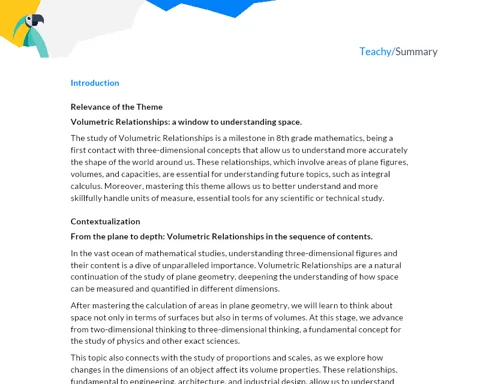Introduction
Relevance of the Topic
Operations with Real Numbers are the backbone of mathematics. They form the basis for learning and applying more advanced concepts in algebra, geometry, calculus, and many other areas of mathematics.
Real Numbers include not only integers, but also rationals and irrationals, such as square roots and recurring decimals. They form an infinite and comprehensive set that can be operated and manipulated in various ways to solve a wide variety of mathematical problems.
Contextualization
In the scope of the mathematics curriculum, Operations with Real Numbers are usually introduced and practiced in the 9th grade of Elementary School after the consolidation of basic arithmetic operations concepts in previous years. At this stage, students learn to combine and apply these concepts to solve more complex and realistic problems.
Operations with real numbers, besides being essential in daily life, are prerequisites for understanding more advanced topics that will be addressed in High School, such as equations, inequalities, functions, and statistics.
Thus, mastering operations with real numbers is not only an end goal in itself, but also a crucial step in the journey towards a deeper and broader understanding of mathematics.
Theoretical Development
Components
-
Addition and Subtraction of Real Numbers: In these operations, the main concern is to maintain the sign and correctly add (or subtract) the integer and decimal parts of the numbers, always considering the rules of signs. It is important to understand that subtracting a real number is nothing more than adding its additive inverse.
-
Multiplication and Division of Real Numbers: In multiplication, it is essential to know how to multiply integers and decimals, and in parallel, observe that the sign of the product depends on the signs of the multiplying factors. In division, it is relevant to remember that dividing two real numbers is equivalent to multiplying the dividend by the multiplicative inverse of the divisor.
-
Combined Operations with Real Numbers: This is the stage where the concepts of addition, subtraction, multiplication, and division converge, and the challenge is to perform the operations correctly, following the rules of precedence and maintaining rigor in the application of the rules of signs, which includes memorizing and applying the acronym "PEMDAS" (parentheses, exponents, multiplication/division, and addition/subtraction).
Key Terms
-
Real Numbers: They are all rational and irrational numbers together, that is, all numbers that can be written in decimal form. This set is infinite and contains numbers like 3, -5, 0.25, π, √2, among others.
-
Arithmetic Operations: These are the basic mathematical actions that allow combining and manipulating numerical quantities. The main arithmetic operations are: addition, subtraction, multiplication, and division.
-
Rules of Signs: These are the conventions that govern how signs (+, -) are manipulated in mathematical expressions. These rules establish, for example, that the sum of two numbers with the same signs is the number with the same sign and that subtracting a number is the same as adding its additive inverse.
Examples and Cases
-
Example 1: Addition and Subtraction of Real Numbers: Adding 2.5 with -4.75, we have: 2.5 + (-4.75) = -2.25. Subtracting 3 from 5.1, we have: 5.1 - 3 = 2.1.
-
Example 2: Multiplication and Division of Real Numbers: Multiplying -2.5 by 4, we have: -2.5 * 4 = -10. Dividing 10 by -2, we have: 10 / -2 = -5.
-
Example 3: Combined Operations with Real Numbers: Evaluating the expression 4 + (6 - 2 * 3) / 2, we have: 4 + (6 - 6) / 2 = 4 + 0 / 2 = 4 + 0 = 4.
Detailed Summary
Key Points
-
The meaning of real numbers: This is the numerical set that encompasses all numbers, including integers, rationals, and irrationals. Understanding this structural concept is essential for advanced mathematical operations.
-
The four operations with real numbers: Adding, subtracting, multiplying, and dividing are the four fundamental operations in mathematics, and they can be performed with real numbers in the same way as with integers and rationals.
-
Rules of signs: The rules of signs are fundamental for effectively operating with real numbers. Understanding and applying these rules correctly is crucial to obtaining the correct answers.
-
Order of operations (PEMDAS): Knowing the correct order to perform operations in an expression (first parentheses, then exponents, then multiplication and division, and lastly addition and subtraction) is essential to avoid errors.
-
Operating with recurring decimals and square roots: Real numbers include recurring decimals (numbers with infinite and periodic decimal places) and square roots of non-perfect numbers. Learning to operate with these types of numbers enhances the understanding and application of the concept of real numbers.
Conclusions
-
Open Mind to Real Numbers: Real numbers are versatile and find applications in many areas of mathematics and sciences. Learning to operate with them paves the way for more advanced fields of mathematics.
-
Signs, Signs, and Signs: Mastering the rules of signs is crucial. They are an inseparable part of operations with real numbers, and misconceptions about them can lead to excessive errors.
-
Practice Makes Perfect: Theory alone is not enough. Practice and continuous problem-solving are the key to mastering operations with real numbers.
Exercises
-
Addition and Subtraction of Real Numbers: Add the following pairs of numbers: a) 3.4 and -2.7; b) -1.8 and -4.2; c) 5.9 and 2.1. Subtract the following pairs of numbers: a) 7.5 from -3.2; b) 5.6 from -2.8; c) -6.9 from -0.1.
-
Multiplication and Division of Real Numbers: Multiply the following pairs of numbers: a) 4.6 by -2.3; b) -3.1 by 1.5; c) 0.8 by 7. Divide the following pairs of numbers: a) 7.6 by -2.8; b) -5.4 by 1.2; c) 4.3 by 2.
-
Combined Operations with Real Numbers: Solve the following expressions: a) 5 - 3 * 2 + 6; b) 15 / (3 - 1 * 4); c) 14 + 6 / (2 - 0.5 * 4).



